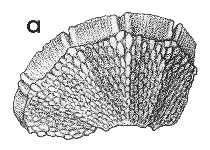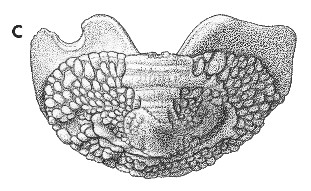
Revised descriptions of New Zealand Cenozoic Mollusca from Beu and Maxwell (1990)

 | Revised descriptions of New Zealand Cenozoic Mollusca from Beu and Maxwell (1990) | 
|
  (Pl. 38a): GS4116, R22/f6436, Nukumaru Brown Sand, Nukumaru Beach, west of Wanganui, Nukumaruan (GNS) (finely sculptured median valve). |
  (Pl. 38b): GS4116, R22/f6436, Nukumaru Brown Sand, Nukumaru Beach, west of Wanganui, Nukumaruan (GNS) (finely sculptured anterior valve). |
  (Pl. 38c): GS4116, R22/f6436, Nukumaru Brown Sand, Nukumaru Beach, west of Wanganui, Nukumaruan (GNS) (coarsely sculptured posterior valve). |
Beu & Maxwell (1990): Chapter 15; p. 305; pl. 38 a-c.
Synonymy: Tonicia rubiginosa Hutton (ex Swainson MS) 1872, p. 180; Acanthochites (Loboplax) costatus A. Adams & Angas of Suter 1897a, p. 194 (not of A. Adams & Angas); Plaxiphora terminalis "Smith" of Wissel 1904, p. 609 (not of Smith); Notoplax (Amblyplax) oliveri Ashby 1926, p. 18; Notoplax (Amblyplax) foveauxensis Ashby 1926, p. 20; Lophoplax finlayi Ashby 1926, p. 30; Acanthochiton foveauxensis Mestayer 1926, p. 585; Acanthochiton foveauxensis var. kirki Mestayer 1926, p. 586; Macandrellus oliveri Mestayer 1926, p. 586; Acanthochites rubiginosus; Acanthochites (Loboplax) rubiginosus; Craspedochiton rubiginosus; Acanthochitona (Notoplax) rubiginosa, Beu & Maxwell 1990, p. 305, pl. 38a-c.
Type species of Amblyplax Ashby, 1926, and of Lophoplax Ashby, 1926 (both considered by Beu & Maxwell (1990) to = Notoplax H. Adams, 1861)
Classification: Acanthochitonidae
Description: Shell moderate-sized (median valves to 10 mm wide and 4 mm long), valves very short and wide; tegmental sculptural granules exceedingly variable in size and regularity. Most characters similar to those of N. mariae (Pl. 44a, d, h); differing in its considerably shorter and wider valves, its shorter insertion plates and sutural laminae, its much more widely triangular jugum on valves 2-8, bearing longitudinal grooves and ridges on many specimens (smooth or weakly pitted in A. mariae and A. zelandica), its ridges on most specimens between lateral and pleural areas of median valves, and its highly variable but, in most specimens, relatively weak radial ridges on anterior valves.
Comparison: Notoplax rubiginosa is one of New Zealand's most abundant living chitons, dredged in large numbers on all firm substrates (such as dead shells) all around New Zealand in about 10-100 m. Not surprisingly, it is also much the most common of Plio-Pleistocene fossil chitons, reflecting the deposition of most diverse shellbeds on the inner to mid-shelf. Valves occur in large numbers in washings of central Hawke's Bay Nukumaruan siltstone (particularly in the outcrop on Ashcott Road at Pukeora Hill, Waipukurau), and small numbers have been examined from Nukumaruan rocks at Wanganui and from many Wanganui Castlecliffian localities and facies (shallow-water sandstone to shellbeds and offshore mudstone); also from Ohope Beach, Whakatane (Castlecliffian; NMNZ) and Te Piki, Cape Runaway (Haweran, oxygen isotope stage 7; NMNZ).
Iredale & Hull (1931, p. 69) thought this was a species of Craspedochiton, and their assignment has been followed by most subsequent authors, yet their earlier figure (Iredale & Hull 1925, pl. 10, fig. 31) of the living tropical Australian Craspedochiton jaubertensis Ashby, 1924 shows that Craspedochiton is an unusual genus with the girdle narrowed posteriorly but widely expanded anteriorly, the anterior valve enlarged, and the girdle lacking spicules. These characters are discordant with N. rubiginosa. Ashby (1926, pp. 6-7) also hotly contested a position in Craspedochiton for any New Zealand species, as all lack the conspicuously fluted insertion plates of such typical species as C. jaubertensis. N. rubiginosa has an evenly narrow girdle all around, a normal-sized head valve, unfluted insertion plates, and a densely spiculous girdle, and seems to be a normal species of Notoplax (sensu lato), if one with an unusually wide tegmentum and narrow girdle. We agree with Leloup (1950, p. 3) that it is best included in Notoplax, at least until a molecular phylogeny of these poorly understood chitons can be undertaken.
Distribution: Nukumaruan-Recent; Recent, Kapiti Island, Cook Strait (type of Tonicia rubiginosa; Hutton (1872, p . 180) stated that the type was from William Swainson's collection, and the name a manuscript one given it by Swainson); Foveaux Strait, southern South Island (types of Notoplax foveauxensis, Acanthochiton foveauxensis, and A. foveauxensis var. kirki); dredged between Kamoau and Tiritiri Islands, Hauraki Gulf, Auckland (type of Notoplax oliveri); Coromandel Peninsula, Hauraki Gulf (type of Macandrellus oliveri); dredged off Otago Heads, south-eastern South Island (type of Lophoplax finlayi, a juvenile specimen of A. rubiginosa). The most common fossil chiton in offshore siltstone facies and shellbeds of Nukumaruan and Castlecliffian age in New Zealand.
Cite this publication as: "A.G. Beu and J.I. Raine (2009). Revised
descriptions of New Zealand Cenozoic Mollusca from Beu and Maxwell (1990). GNS
Science miscellaneous series no. 27."
© GNS Science, 2009
ISBN
978-0-478-19705-1
ISSN 1177-2441
(Included with a PDF facsimile file
copy of New Zealand Geological Survey Paleontological Bulletin 58 in CD version
from: Publications Officer, GNS Science, P.O. Box 30368 Lower Hutt, New
Zealand)